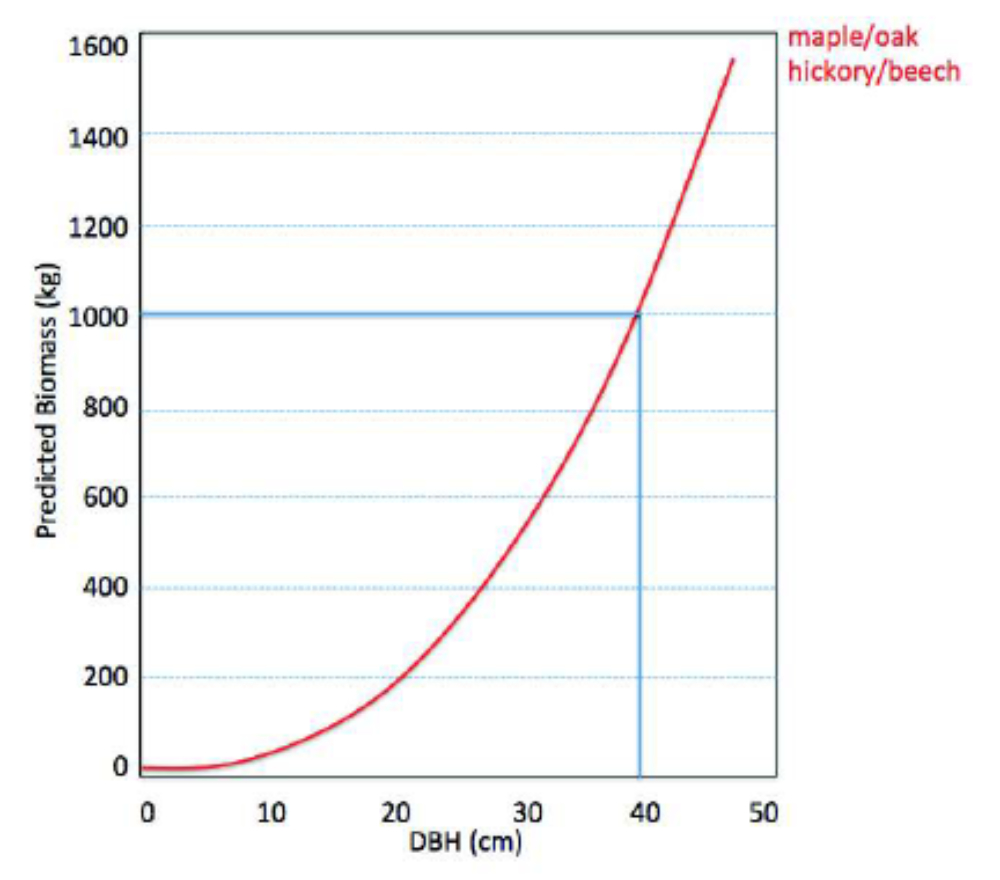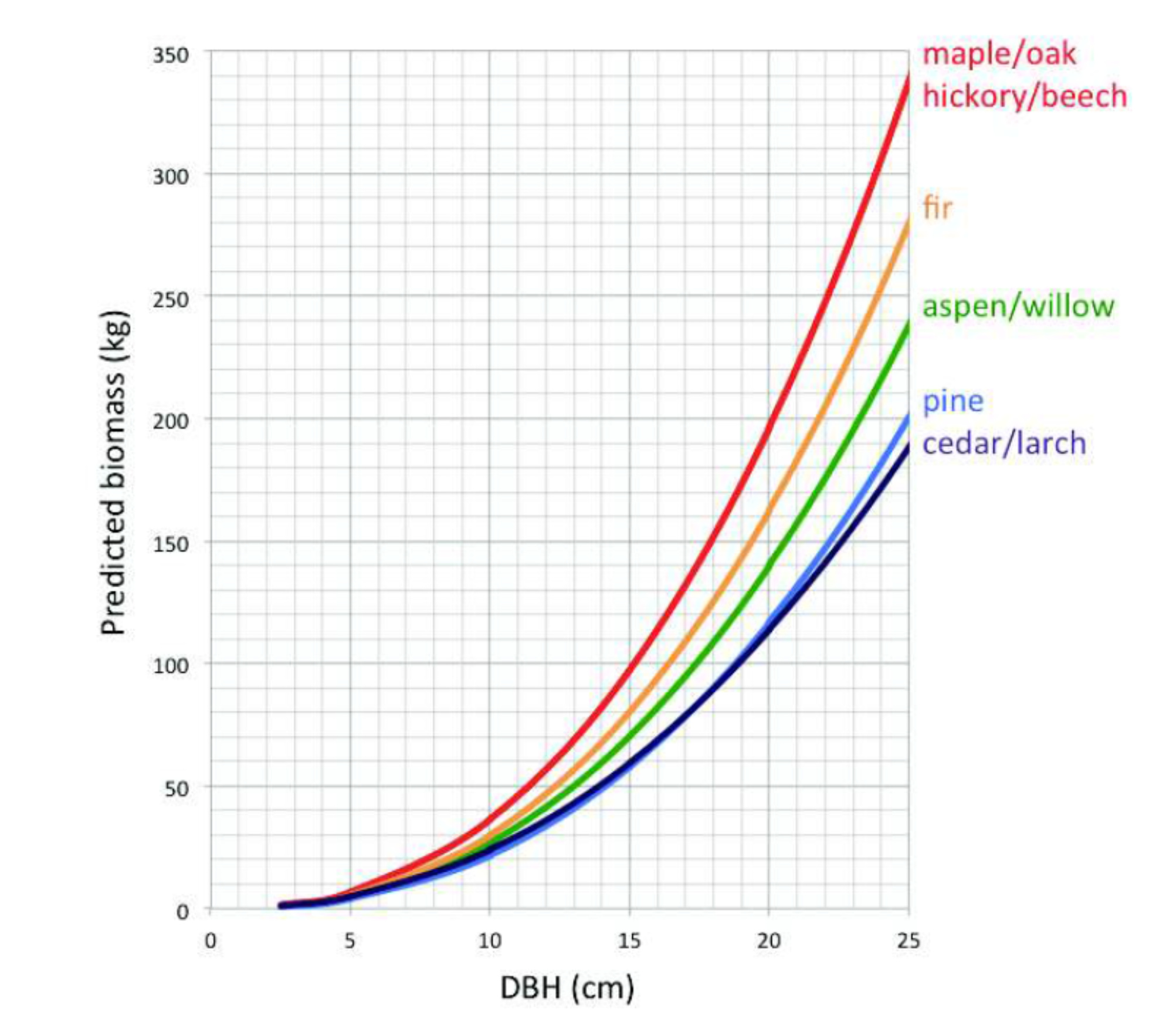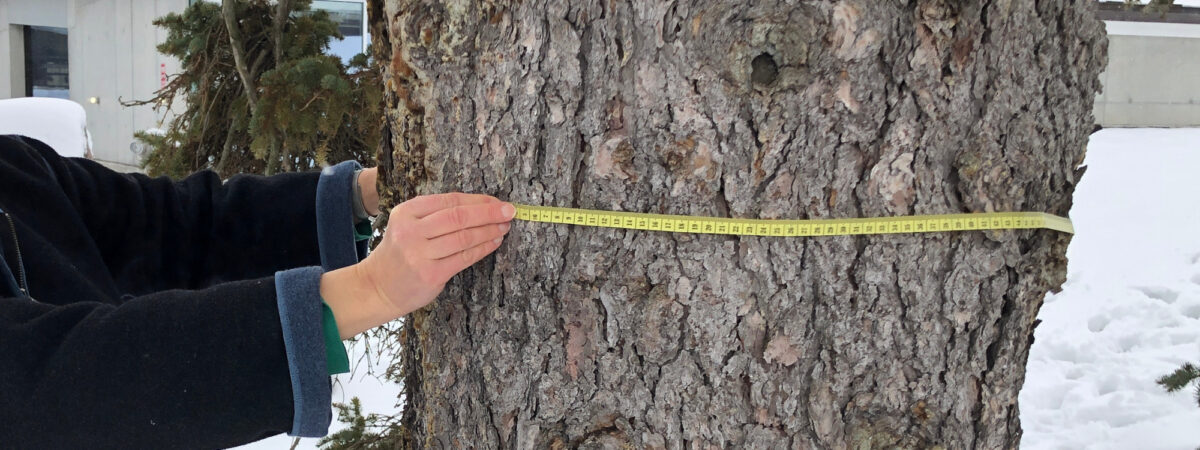Overview
Photosynthesis is the process that builds the biomass of plants, and plants take in carbon dioxide (CO₂) from the atmosphere during photosynthesis. The world's surface temperature is increasing today because of excess CO₂ we are adding to the atmosphere, mainly through burning fossil fuels. Because trees take in CO₂, conserving and restoring forests are important solutions to help us stop heating the planet. But how much CO₂ do trees take in? We can measure how much CO₂ a given tree has taken in over its lifetime.
Introduction
Students measure the circumference of a tree, calculate the diameter based on the circumference, read a graph that relates tree diameter to biomass, and then compute the mass of carbon dioxide taken in by the tree, based on the estimated biomass.
Grade Level
6-8, 9-12
Learning Objectives
Students will
- make measurements of living trees
- practice reading graphs
- practice geometry skill of converting circumference to diameter
- practice computations that show understanding of molecular mass
Lesson Format
The measurements should ideally be made outdoors on living trees. If trees or outdoor access are not available, students could imagine a tree of a certain diameter, or measure the circumference of a cylinder that is similar in diameter to a tree, and do the remainder of the activity without making tree measurements.
Time Required
30 - 45 minutes
Standards
NGSS
- From Molecules to Organisms: Structures and Processes: Construct a scientific explanation based on evidence for the role of photosynthesis in the cycling of matter and flow of energy into and out of organisms. MS-LS1-6
- Ecosystems: Interactions, Energy, and Dynamics: Develop a model to illustrate the role of photosynthesis and cellular respiration in the cycling of carbon among the biosphere, atmosphere, hydrosphere, and geosphere. HS-LS2-5
Credits & Contact Info
Dr. Alexandra Moore
Paleontological Research Institution, 1259 Trumansburg Rd., Ithaca NY 14850
moore@priweb.org
Instructions & Materials
Materials
- Tape measure (with centimeters) or forester's DBH (diameter at breast height) tape
- Graph of DBH vs. Tree Biomass (included here)
- Calculator
- Tree
Overview
Photosynthesis is the process that builds the biomass of plants. Biomass is the dry mass of live or dead matter from a tree or shrub; it does not include the mass of water within a plant.
Within leaves, carbon dioxide enters through pores called stomata, where it reacts with water to form glucose and oxygen molecules. The oxygen exits the leaf through the same stomata.
light
6CO₂ + 6H₂O = C₆H₁₂O₆ + 6O₂
carbon dioxide + water = glucose + oxygen
In this reaction light energy from the sun is converted into chemical energy stored in the glucose molecule. Once in the leaf, the glucose is transformed through additional reactions into a range of new compounds, such as the lignin (C₃₁H₃₄O₁₁) and cellulose (C₆H₁₀O₅) that form the mass of trees. While a plant needs a small amount of additional nutrients for healthy growth (N, P, K), the mass of these additions is very small and accounts for only a tiny fraction of the mass of the plant. In a tree, approximately 50% of the biomass is derived from the carbon that enters the leaves as the invisible atmospheric gas CO₂.
Can we measure the mass of a tree and find out how much CO₂ it holds? That would be easy to do if we were to cut it down, and cut it into small enough pieces to put onto a scale. But that job itself is difficult, and it is certainly hard on the tree. If we could measure or estimate the volume of a tree we could calculate its mass. But trees have very irregular shapes, and it might at first seem difficult or impossible to calculate the biomass of such an unusually-shaped object.
Fortunately, the US Forest Service (and others) have taken the trouble to cut down and weigh a lot of trees of many species, and from these data have developed relationships between the mass of trees and measurements that are easy to make. Graph 1 is a graph of the relationship between a tree’s Diameter at Breast Height (DBH) and mass for ten different species of trees. In this relationship the diameter is measured in centimeters and the mass is given in kilograms.
Procedure
DBH is measured 4.5 feet above the ground. It is not critical to measure at exactly this height; it is more important to avoid bumps and branches on the trunk. DBH is not measured directly, rather, we measure the circumference of the trunk and calculate the diameter, as in Figure 1:
Figure 1
Step 1: Identify the tree species
Species:_______________________________________
If you are working with a regular tape measure you will measure and record the circumference, in units of centimeters, then divide the circumference by π to find the diameter. If you have a forester’s DBH tape you can read the circumference from one side, then flip the tape over to read the diameter on the back side.
Step 2: Measure the circumference and calculate diameter
Circumference (cm): _________________
Diameter (cm):______________________
Once you have calculated the diameter, use Graph 1 or 2 (below) to find the appropriate mass of the tree in kilograms.
Example (Figure 2): A Sugar Maple tree with a DBH=40 cm has a mass of 1000 kg.

Figure 2
Step 3: Use Graph 1 to find the tree's biomass
NOTE: for trees with small diameters (less than about 25 cm), Graph 1 can be difficult to read because all the curves converge near the origin. In this case, use Graph 2 (below).
Mass (kg):______________________
One kilogram is approximately 2 pounds (1 kg = 2.2 lb). A 1000 kg tree weighs 2200 pounds!

Graph 1: U.S. Forest Service data relating tree diameter at breast height to biomass (Jenkins et al, 2003). Graph by Alexandra Moore.

Graph 2: U.S. Forest Service data relating tree diameter at breast height to biomass (Jenkins et al, 2003). For this graph, the horizontal scale has been expanded to make the data easier to read for trees with small diameters. Graph by Alexandra Moore.
We also know that half of the mass of the tree is made of carbon. So we can also calculate how much atmospheric carbon the tree stores.
Step 4: Calculate the mass of carbon in the tree (Carbon mass = Tree mass/2)
Mass C (kg): _______________________
This is important because carbon dioxide is a Greenhouse Gas – a gas that absorbs long-wavelength (heat) energy – that keeps the atmosphere warm. A little CO₂ in the atmosphere keeps Earth comfortably habitable for human beings, but too much atmospheric CO₂ leads to global warming which disrupts normal Earth system processes. All of the carbon that you calculated for your tree came from the atmosphere. It was incorporated into the tree during photosynthesis. So we can show that trees are able to remove a lot of excess CO₂ from the atmosphere! And in fact, we can take the mass of carbon calculated in Step 4 and turn it into the mass of carbon dioxide that each tree stores.
Step 5: Use the mass of carbon in the tree to find the mass of carbon dioxide the tree has removed from the atmosphere.
For every carbon atom, a CO₂ molecule also contains two oxygen atoms. So the amount of CO₂ per kg of carbon in the tree is the ratio of the mass of CO₂ (molecular mass=44) to the mass of carbon (atomic mass=12).
Mass CO₂ (kg) = Result from Step 4 x (44/12): ___________________________________
Finally we can think about one more important aspect of out tree – the roots! Roots contribute to the total mass of the tree and thus the total amount of CO₂ stored. The biomass charts - and the underlying equations that we use to make the charts – come from the work of foresters who are interested in the above-ground part of the tree. If we assume that there is an additional 25% of the tree below ground we can refine out calculation from Step 5 by multiplying it by 1.25.
Step 6: Find the total mass of CO₂ in both the “roots and shoots” of the tree (=CO₂ x 1.25)
Total Mass of stored CO₂ (kg): ________________________________
Background & Extensions
Learn more about photosynthesis and trees as climate solutions in these videos
Compare tree carbon sequestration to energy use and greenhouse gas emissions
Your students can use the U.S. EPA's Greenhouse Gas Equivalencies Calculator to compare amounts of energy used or greenhouse gas emissions to the equivalent carbon sequestration from trees planted, acres of U.S. forest, or forests prevented from being converted to farmland.The calculator provides background information on how its calculations are done.
Teaching Tip: In discussions of trees and forests as climate change mitigation solutions, it is important to note that trees and forests provide many other benefits beyond carbon sequestration, and they can also help us adapt to climate change. Forests clean pollutants out of the air and water, soak up stormwater to prevent flooding, prevent soil erosion, reduce noise pollution, and provide critical habitat for animals as well as jobs, food, recreation, ingredients for medicines, and other benefits. Additionally, trees in urban and suburban environments provide life-saving shade and cooling and increase property values. Finally, using forests to pull carbon dioxide out of the air is much less expensive than technological solutions such as direct air capture or carbon capture technology that has been used by the oil and gas industry.
Learn More
Climate Change Mitigation chapter of The Teacher-Friendly Guideᵀᴹ to Climate Change on the Digital Encyclopedia of Earth Science



